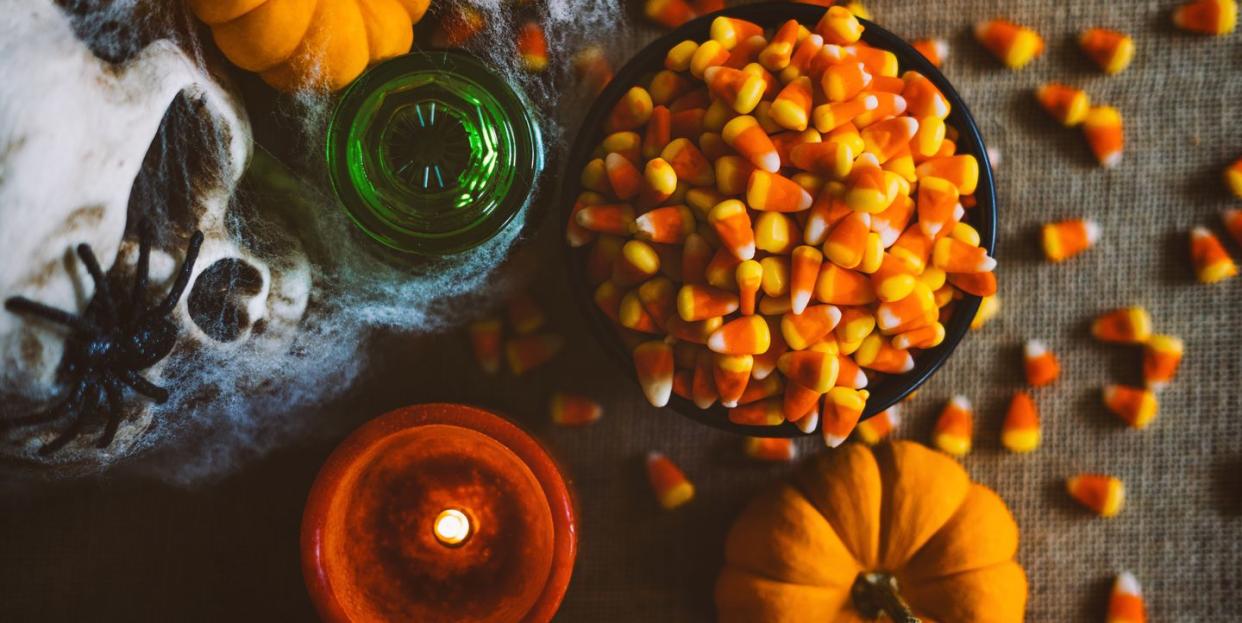The Healthiest Halloween Candy, According to Nutritionists

Let’s just get this out of the way: Halloween isn’t a healthy holiday. And no one’s really dishing out niche, “good-for-you” alternatives. And that’s OK. Eat the candy! Halloween is one day, and eating a candy bar isn’t going to kill you. The problem is that Halloween candy tends to linger, and it’s hard to say no when you’re still staring at it two, four, seven days later. That’s when you want to be smart about how much you’re actually consuming.
“We should all be limiting calories from added sugars to no more than 10 percent each day according to the 2015-2020 Dietary Guidelines for Americans,” says Pamela Nisevich Bede, R.D., author of the upcoming Sweat.Eat.Repeat. “If you were to consume 2,000 calories a day (a fairly typical intake), that means no more than 200 calories, or 50 grams of added sugars a day.” For reference, a 1.5-ounce Kit Kat has 21 grams of sugar, a 1.56-ounce Snickers has 20 grams of sugar, and a 15-gram pouch of Swedish fish has almost 12 grams of sugar. Try to avoid treats that list sugar (whether that’s table sugar or other forms like brown sugar or corn syrup) in the first two ingredients.
If you have a choice between milk or dark chocolate, opt for the latter. “The benefits of chocolate come from flavanols, which are found in the cocoa bean—and the more cocoa, the better it is for you,” says Natalie Rizzo, R.D., author of The No-Brainer Nutrition Guide for Every Runner. “Since milk chocolate has way less cocoa (about 10 percent) than dark chocolate (minimum 35 percent), it loses its nutritional benefits.” Milk chocolate is also made with more condensed milk, which ups the sugar content compared to dark chocolate. “A milk chocolate bar will have about double the amount of sugar as a dark chocolate bar with 70 percent cocoa,” adds Rizzo.
Think you’re doing yourself a favor by opting for gummies or sugar candies? (These carb-bombs are basically energy chews, right?) “They are sometimes lower in calories than chocolate, because they don’t have the cocoa butter (fat) that chocolate has, but they still have just as much—or even more—sugar than chocolate,” says Rizzo. “For example, a pack of Skittles has 250 calories and 46 grams of sugar, and a Snicker’s bar has 280 calories and 29 grams of sugar.” Chocolate or nutty treats offer protein and fat in addition to carbs, and those macronutrients do more than simply energize, adds Bede. “If you’re choosing between sugar or fat + sugar + protein, go with the source that offers slightly more nutrition for your calorie spend.”
Don’t be a martyr by choosing the snack-size option, either. Yes, “many full-size candies contain the same number of calories as a healthy, filling meal,” says Bede. And snack-size treats do help with portion control. If you have the discipline to eat just one, obviously that’s better for you. “But if you’re going to end up eating 20 pieces, then you might as well just eat one regular-sized candy bar. It’s all about moderation!” says Rizzo.
TK
You Might Also Like

